#South africa work
Text
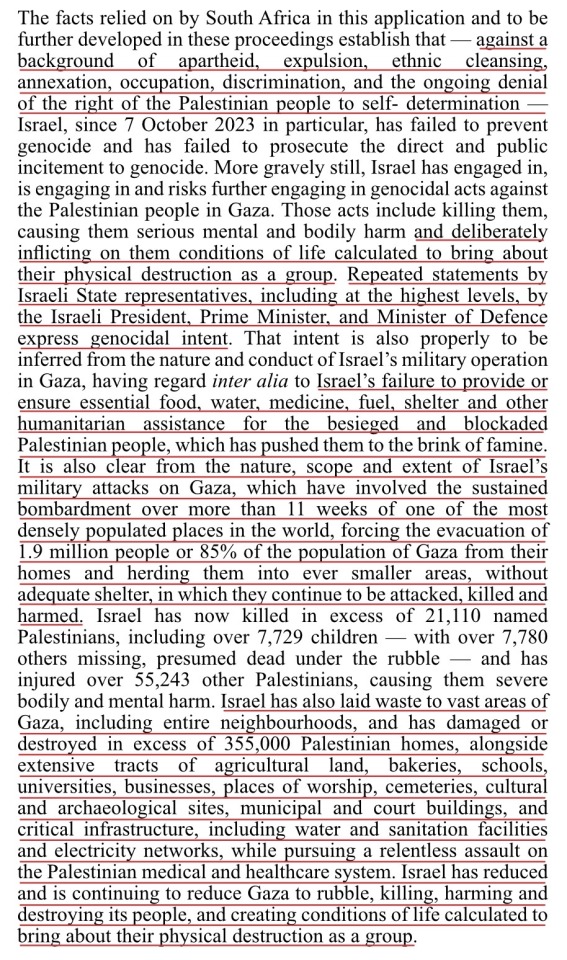
from South Africa's genocide case against Israel before the International Court of Justice [ID'd]
#working on compiling a summary and/or excerpts from the case as i make my way through it#south africa#israel#palestine#free palestine#geopol#icj israel genocide
621 notes
·
View notes
Text
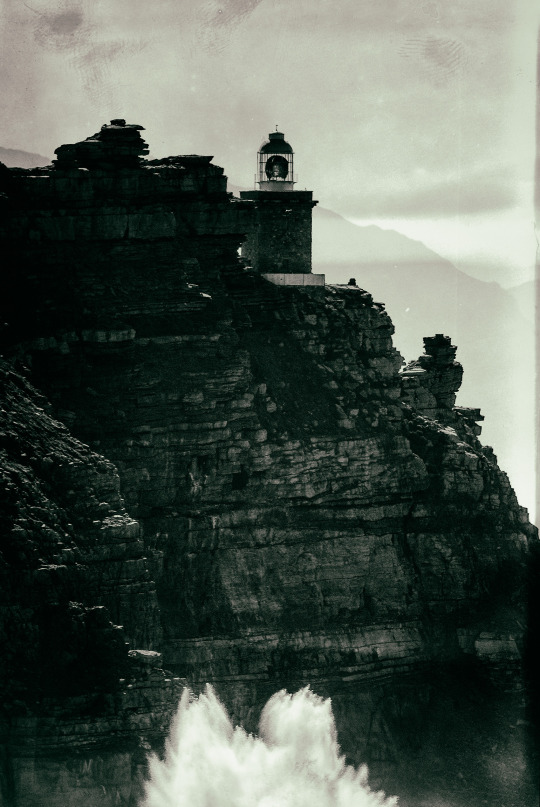
a mighty light on a 9m high tower with breaker waves
photography + © Christof Keßemeier
71 notes
·
View notes
Text

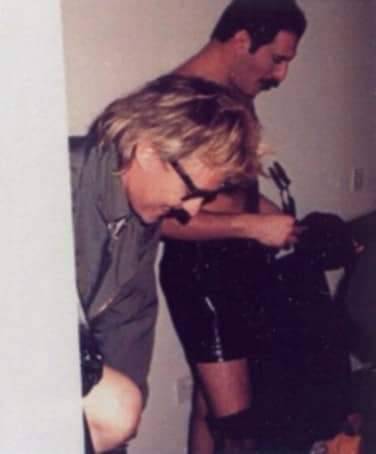


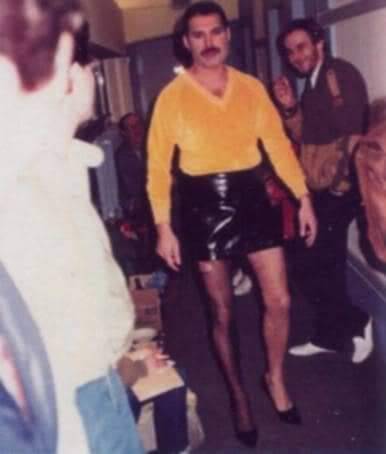
Today - March 22nd, 1984 - Queen Story!
London, UK - Queen videoed "I Want To Break Free"
The video for this song parodies a popular British television soap, Coronation Street. The opening sequence features all the band members in drag (Mercury as a housewife, Deacon as grandmother, Taylor as a schoolgirl, and May as a housewife). This confused many people who didn't catch the reference. Brian May was asked in an interview with Q magazine March 2011 whether each band member's character in the video was an accurate reflection of their personalities? He replied: "Of Course! Everybody thinks that was Freddie's idea because it looks like something that he would love to do but it actually came from Roger's girlfriend at the time, strangely enough. It was her idea to pastiche the Coronation Street women."
Location Docklands Limehouse Studio
Directed by David Mallet, with hundreds of fan club members dressed as miners as film extras
Freddie Mercury was all set to shave off his trademark mustache, but director David Mallet put a stop to it: "I said, 'No, the one thing you musn't do, the funny thing is that your mustache is there and you're in drag!' To this day, when he comes around the corner with that hoover I laugh." In this video Mercury is surrounded by the Royal Ballet in a nod to the French ballet L'Après-midi d'un faune and its clean-shaven Russian star Vaslav Nijinsky.
This song became an anthem for the ANC in South Africa in the late '80s when Nelson Mandela was still in jail and the white government's apartheid policies were still in place.
(➡️ source: songfacts.com)
#i want to break free#freddie mercury#queen band#london#zanzibar#legend#queen#brian may#john deacon#freddiebulsara#roger taylor#promo video#1984#davidmallet#uk#the works album#coronation street#mandela#south africa#Spotify
62 notes
·
View notes
Text
This Body Works For Me


This Body Works For Me is a popular South African TV show that focuses on the lives of 7 sex workers.
I think it’s heartbreaking that more South African girls and women are being pushed into sex work due to economic circumstances.
All of the women on this show became strippers/porn stars/hook up girls because they had financial issues. Many of them also come from harsh backgrounds filled with trauma.
It’s even sadder that young South African women have adopted the liberal “sex work is work” mindset and nobody is discussing the evils of the sex industry, especially in a country with one of the highest rape and femicide rates in the world.
#this body works for me#liberal feminism#Africa#African#south africa#anti sex work#radical feminists do interact#radical feminism#radfem#radfem safe#radfems please interact#radical feminists please touch#radical feminist
298 notes
·
View notes
Text
I love how everyone said, “See the UN will say it’s a genocide!” And then when they said there isn’t enough evidence than it doesn’t matter and is all propaganda.
Ok babe, this totally makes sense.
#jumblr#i stand with israel#antisemitism#un#south africa icj#lmaoooooo#it’s only when it works out for you#dumbasses
46 notes
·
View notes
Text
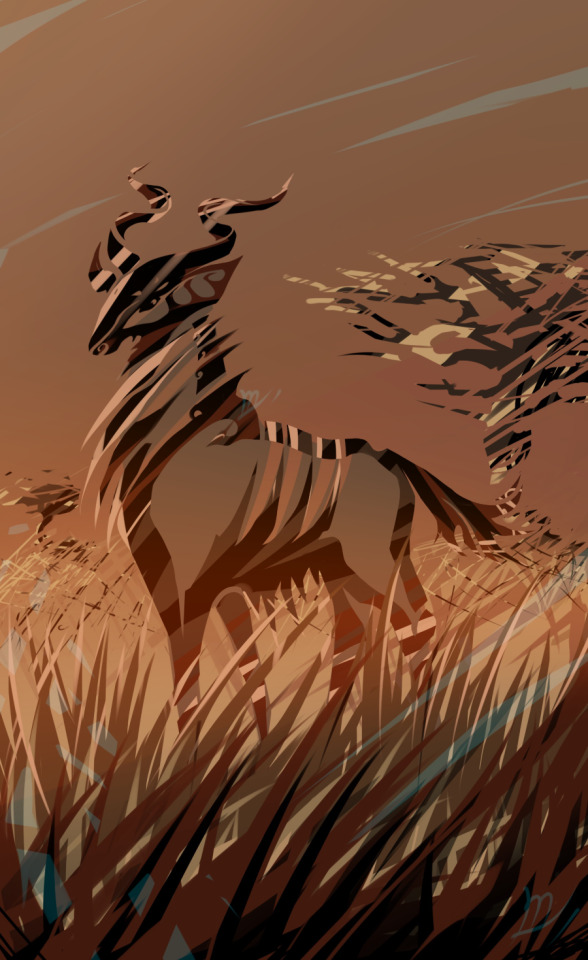
It’s kinda just started to sink in - the things I f* saw with my own two eyes
omg
#my art#south africa#cause this is africa#some kind of antelope#my personal favourites are nyalas#kudu is fine too#Omg#OMG#can you believe it#like I knew the place exists#I’ve seen pictures documentaries etc#but one thing is to know#and another thing is to see for yourself#omg#i hope one day I’ll see all the other amazing things that I theoretically know about#back to work#we need all the money#to actually see things while it’s not too late
114 notes
·
View notes
Text

Breaking News! UC Davis Breaks from Israel!
Link to video full of cheering HERE.
Original tweet is by user @CocktCapitalism , an anticapitalist podcast “that pairs crafted beverages with stories distilled from our capitalist hellscape.”
I’m looking for more sources to help us understand what UCD is and how divestment works and why this is significant, will add as I find them :)
ETA: some recent info about this protest movement can be found here via the UC campus newspaper “the Daily Bruin”.
ETA 2: Define “Divestment”- “the act of selling off a business or businesses, or of no longer investing money in something: a campaign to encourage divestment from fossil fuels” source
ETA 3: Some relevant Background on UCD’s divestment from Fossil Fuels (and how that hasn’t been perfect) c. 2020 can be found in the Guardian here.
ETA 4: this is hella old (1986) but relevant for how UCD’s divestment impacted the South African apartheid and its subsequent ending, can be found via WaPo here.
Text description beneath cut for the comrades who use it.
A tweet from @CocktCapitalism, which reads:
BREAKING: UC Davis has divested from apartheid Israel. The bill prevents the ASUCD’s $20 mill budget from being spent “on companies complicit in the occupation and genocide.”
This is huge. University divestment efforts played a massive role in ending South African apartheid.”
Two images are included, one is a still of people cheering (link above) and the other a protest poster/ flier which proclaims UCD Has Divested, with red and green Palestinian colors.
#free palestine#palestine#gaza#free gaza#divestment#bds Palestine#a victory#boycott divest sanction#protest#protest works#collective action#collective action works#we will free Palestine#solidarity#background info#definition#history#South Africa#apartheid#economic divestment#from the river to the sea palestine will be free
29 notes
·
View notes
Text
cant ask questions in calc class. i sit next to two sexy men and I cant afford to think that they are smarter than me
#🔪 - mello talks too much#discord server already knows#but one dude is straight from south africa and the other dude is 6'5 or 6'6#who will mello choose????#ill prob be able to pull the south african guy bc we are kinda friends now but the 6'5 guy....#he is so quiet and so not interested in me LMAOOO#but also maybe i should just look dumb so that they can “help” me with my work#girlhood
40 notes
·
View notes
Text

Tollbooth worker - near Cape Town, 2023
#travel#south africa#original photographers#photographers on tumblr#street photography#street portrait#b&w photography#monochrome#b&w portrait#working woman#tollbooth
20 notes
·
View notes
Text
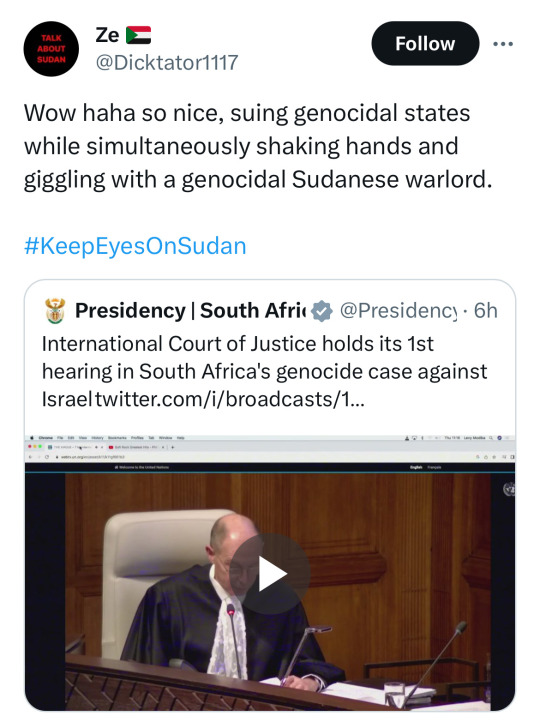
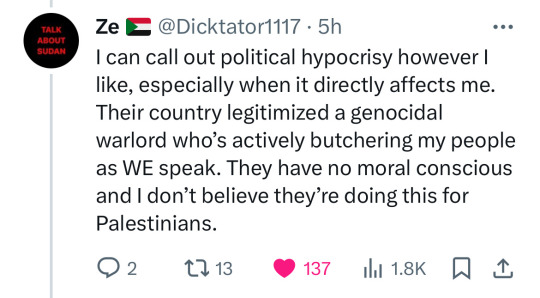

Presidency of South Africa twitter, "International Court of Justice holds its 1st hearing in South Africa's genocide case against Israel"
(Ze🇸🇩 in reply to Presidency of South Africa twitter): Wow haha so nice, suing genocidal states while simultaneously shaking hands and giggling with a genocidal Sudanese warlord.
(Ze🇸🇩 in thread): I can call out political hypocrisy however I like, especially when it directly affects me. Their country legitimized a genocidal warlord who’s actively butchering my people as WE speak. They have no moral conscious and I don’t believe they’re doing this for Palestinians.
(@Kandakat_alhaqq): Did you guys know that Omar Al-Bashir was wanted by the ICC for a genocide when he visited SA in 2015, the same crimes South Africa is suing Isnotreal for and SA refused to arrest him? Did you know that SA met with Hemeti, general of the RSF militia that’s committing all sorts of atrocities just last week? Did you know they called him “President” on a tweet and then deleted it? Did you know Hemeti is also complicit in the same genocide (Darfur) Omar Al-Bashir was wanted for by ICC? No? Well now you know. While SA plays hero in front of the world, they most certainly are not for the Sudanese people.

(Above picture, image description by The East African;
Leader of Sudan's paramilitary Rapid Support Forces (RSF) Mohamed Daglo (left) when he visited South African President Cyril Ramaphosa at his official residence in Pretoria on January 4, 2024):
Sudan paramilitary leader [RSF] holds talk with [South Africa's] President Ramaphosa
#sudan#keepeyesonsudan#south africa#icc#geopolitics#geopol#note: sorry for not including @kandakat_alhaqq's twitter name or heading#the characters would not work and kept formatting to arabic#so the emojis wouldn't work as i wanted them to
27 notes
·
View notes
Text
On May 28, 1914, the Institut für Schiffs-und Tropenkrankheiten (Institute for Maritime and Tropical Diseases, ISTK) in Hamburg began operations in a complex of new brick buildings on the bank of the Elb. The buildings were designed by Fritz Schumacher, who had become the Head of Hamburg’s building department (Leiter des Hochbauamtes) in 1909 after a “flood of architectural projects” accumulated following the industrialization of the harbor in the 1880s and the “new housing and working conditions” that followed. The ISTK was one of these projects, connected to the port by its [...] mission: to research and heal tropical illnesses; [...] to support the Hamburg Port [...]; and to support endeavors of the German Empire overseas.
First established in 1900 by Bernhard Nocht, chief of the Port Medical Service, the ISTK originally operated out of an existing building, but by 1909, when the Hamburg Colonial Institute became its parent organization (and Schumacher was hired by the Hamburg Senate), the operations of the ISTK had outgrown [...]. [I]ts commission by the city was an opportunity for Schumacher to show how he could contribute to guiding the city’s economic and architectural growth in tandem, and for Nocht, an opportunity to establish an unprecedented spatial paradigm for the field of Tropical Medicine that anchored the new frontier of science in the German Empire. [...]
[There was a] shared drive to contribute to the [...] wealth of Hamburg within the context of its expanding global network [...]. [E]ach discipline [...] architecture and medicine were participating in a shared [...] discursive operation. [...]
---
The brick used on the ISTK façades was key to Schumacher’s larger Städtebau plan for Hamburg, which envisioned the city as a vehicle for a “harmonious” synthesis between aesthetics and economy. [...] For Schumacher, brick [was significantly preferable] [...]. Used by [...] Hamburg architects [over the past few decades], who acquired their penchant for neo-gothic brickwork at the Hanover school, brick had both a historical presence and aesthetic pedigree in Hamburg [...]. [T]his material had already been used in Die Speicherstadt, a warehouse district in Hamburg where unequal social conditions had only grown more exacerbated [...]. Die Speicherstadt was constructed in three phases [beginning] in 1883 [...]. By serving the port, the warehouses facilitated the expansion and security of Hamburg’s wealth. [...] Yet the collective profits accrued to the city by these buildings [...] did not increase economic prosperity and social equity for all. [...] [A] residential area for harbor workers was demolished to make way for the warehouses. After the contract for the port expansion was negotiated in 1881, over 20,000 people were pushed out of their homes and into adjacent areas of the city, which soon became overcrowded [...]. In turn, these [...] areas of the city [...] were the worst hit by the Hamburg cholera epidemic of 1892, the most devastating in Europe that year. The 1892 cholera epidemic [...] articulated the growing inability of the Hamburg Senate, comprising the city’s elite, to manage class relationships [...] [in such] a city that was explicitly run by and for the merchant class [...].
In Hamburg, the response to such an ugly disease of the masses was the enforcement of quarantine methods that pushed the working class into the suburbs, isolated immigrants on an island, and separated the sick according to racial identity.
In partnership with the German Empire, Hamburg established new hygiene institutions in the city, including the Port Medical Service (a progenitor of the ISTK). [...] [T]he discourse of [creating the school for tropical medicine] centered around city building and nation building, brick by brick, mark by mark.
---
Just as the exterior condition of the building was, for Schumacher, part of a much larger plan for the city, the program of the building and its interior were part of the German Empire and Tropical Medicine’s much larger interest in controlling the health and wealth of its nation and colonies. [...]
Yet the establishment of the ISTK marked a critical shift in medical thinking [...]. And while the ISTK was not the only institution in Europe to form around the conception and perceived threat of tropical diseases, it was the first to build a facility specifically to support their “exploration and combat” in lockstep, as Nocht described it.
The field of Tropical Medicine had been established in Germany by the very same journal Nocht published his overview of the ISTK. The Archiv für Schiffs- und Tropen-Hygiene unter besonderer Berücksichtigung der Pathologie und Therapie was first published in 1897, the same year that the German Empire claimed Kiaochow (northeast China) and about two years after it claimed Southwest Africa (Namibia), Cameroon, Togo, East Africa (Tanzania, Burundi, Rwanda), New Guinea (today the northern part of Papua New Guinea), and the Marshall Islands; two years later, it would also claim the Caroline Islands, Palau, Mariana Islands (today Micronesia), and Samoa (today Western Samoa).
---
The inaugural journal [...] marked a paradigm shift [...]. In his opening letter, the editor stated that the aim of Tropical Medicine is to “provide the white race with a home in the tropics.” [...]
As part of the institute’s agenda to support the expansion of the Empire through teaching and development [...], members of the ISTK contributed to the Deutsches Kolonial Lexikon, a three-volume series completed in 1914 (in the same year as the new ISTK buildings) and published in 1920. The three volumes contained maps of the colonies coded to show the areas that were considered “healthy” for Europeans, along with recommended building guidelines for hospitals in the tropics. [...] "Natives" were given separate facilities [...]. The hospital at the ISTK was similarly divided according to identity. An essentializing belief in “intrinsic factors” determined by skin color, constitutive to Tropical Medicine, materialized in the building’s circulation. Potential patients were assessed in the main building to determine their next destination in the hospital. A room labeled “Farbige” (colored) - visible in both Nocht and Schumacher’s publications - shows that the hospital segregated people of color from whites. [...]
---
Despite belonging to two different disciplines [medicine and architecture], both Nocht and Schumacher’s publications articulate an understanding of health [...] that is linked to concepts of identity separating white upper-class German Europeans from others. [In] Hamburg [...] recent growth of the shipping industry and overt engagement of the German Empire in colonialism brought even more distant global connections to its port. For Schumacher, Hamburg’s presence in a global network meant it needed to strengthen its local identity and economy [by purposefully seeking to showcase "traditional" northern German neo-gothic brickwork while elevating local brick industry] lest it grow too far from its roots. In the case of Tropical Medicine at the ISTK, the “tropics” seemed to act as a foil for the European identity - a constructed category through which the European identity could redescribe itself by exclusion [...].
What it meant to be sick or healthy was taken up by both medicine and architecture - [...] neither in a vacuum.
---
All text above by: Carrie Bly. "Mediums of Medicine: The Institute for Maritime and Tropical Diseases in Hamburg". Sick Architecture series published by e-flux Architecture. November 2020. [Bold emphasis and some paragraph breaks/contractions added by me. Text within brackets added by me for clarity. Presented here for commentary, teaching, criticism purposes.]
#abolition#ecology#sorry i know its long ive been looking at this in my drafts for a long long time trying to condense#but its such a rich comparison that i didnt wanna lessen the impact of blys work here#bly in 2022 did dissertation defense in architecture history and theory on political economy of steel in US in 20s and 30#add this to our conversations about brazilian eugenics in 1930s explicitly conflating hygiene modernist architecture and white supremacy#and british tropical medicine establishment in colonial india#and US sanitation and antimosquito campaigns in 1910s panama using jim crow laws and segregation and forcibly testing local women#see chakrabartis work on tropical medicine and empire in south asia and fahim amirs cloudy swords#and greg mitmans work on connections between#US tropical medicine schools and fruit plantations in central america and US military occupation of philippines and rubber in west africa
13 notes
·
View notes
Text

above the boiling sea
photography + © Christof Keßemeier
63 notes
·
View notes
Text
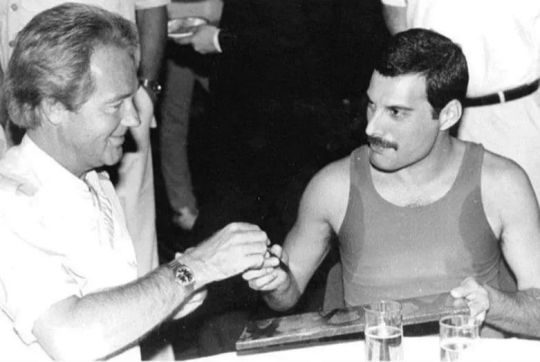
October 1984, Sun City - Freddie Mercury during and interview signing autographs
👉 October 1984 - Queen in South Africa for 9 concerts during the 'Works!' Tour
👉 First concert on October 5th 1984

October 1984 - Queen in South Africa for 9 concerts during the 'Works!' Tour
- First concert on October 5th 1984
👉 PinkFlamingo Twitter
@ladistardust
"Downsizing after 34 years & I’m finding all sorts of treasures hiding everywhere.
Like this pic of Freddie, I took at the presser during their 1984 tour of Sun City.
I was a full time photographer for the national broadcaster, the SABC. All the memories..."
Freddie Mercury during a interview
#freddie mercury#queen band#london#zanzibar#legend#queen#brian may#john deacon#freddiebulsara#roger taylor#works tour 1984 1985#1984#suncity#south africa#workstour
24 notes
·
View notes
Text
The og colonisers doing what they do best kill people that don’t agree with them. Mind you the houthis have not murdered anyone since they stopped ships from going through the Red Sea but America cares more about the money they have to make and lose than human life (Palestinians and Yemenis)
#yemeni#I am 100% not suprised at all#they worked so quickly and bombed Yemen instead of stopping mistake from murdering people#free palestine 🇵🇸#free gaza#Palestine#houthis#they don’t even care about their own citizens in any case#but anyways go hard for a government that doesnt care about anyone beside money#yemen#icj#they were at a hearing but starting kill more people#South Africa
11 notes
·
View notes
Text
i have been way too fucking quiet on my blog about this shit despite my views.
KEEP BOYCOTTING SHIT.
IT IS WORKING.
KEEP LOOKING AT THESE AWFUL FUCKING STATISTICS.
THEY ARE ABHORRENT.
KEEP STANDING FOR WOMEN IN SOUTH AFRICA.
THEY ARE BEING MURDERED AND RAPED.
DO NOT STAY SILENT.
DO NOT LET MEDIA SILENCE AND CENSOR YOU.
WE WILL LOSE IF WE ARE QUIET.
#free palestine#boycott israel#boycott starbucks#boycott mcdonalds#boycott disney#boycott divest sanction#BOYCOTT.#boycotts work#women in south africa#stay loud#palestine#free gaza#gaza#from the river to the sea#🍉
10 notes
·
View notes
Text

Filming of Season 3 has wrapped.
#wheel of time#wot on prime#wot spoilers#wot season 3#think there's still some location filming in south africa#but looks like all the majority of filming and all the studio work in prague is done#now comes the long post process#if it takes as long as s2 we're looking at march-april 2025 for an airdate#these waits are gonna kill me
16 notes
·
View notes